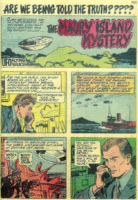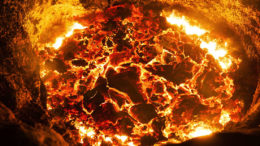by Charles Lear
 Tales of UFOs ejecting hot metal go back to the days when flying saucers were just becoming an American national obsession. In fact, the first flying saucer witness, Kenneth Arnold, encountered such a tale when he looked into the Maury Island Incident for Fate magazine and became the first privately funded flying saucer investigator. In this week’s blog, we’ll take a look at an incident that was reported 30 years later in Council Bluffs, Iowa.
Tales of UFOs ejecting hot metal go back to the days when flying saucers were just becoming an American national obsession. In fact, the first flying saucer witness, Kenneth Arnold, encountered such a tale when he looked into the Maury Island Incident for Fate magazine and became the first privately funded flying saucer investigator. In this week’s blog, we’ll take a look at an incident that was reported 30 years later in Council Bluffs, Iowa.
According to an article by Jason Offutt for the Eastern Jackson County, Missouri, Daily Examiner published online on February 9, 2011, Mike Moore was driving through Big Lake Park with his wife at 7:45 p.m. on Saturday Dec. 17, 1977, when they saw “this big ball of red stuff in the sky.” Moore said it hovered, dropped something on fire into the park, and then flew away.
According to an article by Richard Warner published on the website of the Historical and Preservation Society of Pottawattamie County (Council Bluffs, Iowa), at 7:45 p.m. that same night, three teenagers driving to a store observed what seems to be the same falling red ball. It went behind some trees in Big Lake Park. Then, there was a bluish-white flash and two “arms of fire” were seen that shot out more than ten feet into the air.
 Thinking there had been some sort of crash, they drove to the park to investigate. They got out and walked towards a glow on a dike along the road. When they got close they saw a glowing orange blob with a bluish-white, crystalline center. One of the witnesses described it as looking like “a great big sparkler.” Material reportedly dripped over the sides of the dike that was hot enough to start a small fire in the grass.
Thinking there had been some sort of crash, they drove to the park to investigate. They got out and walked towards a glow on a dike along the road. When they got close they saw a glowing orange blob with a bluish-white, crystalline center. One of the witnesses described it as looking like “a great big sparkler.” Material reportedly dripped over the sides of the dike that was hot enough to start a small fire in the grass.
According to an article by Gregg Jarrett for the Southwest Iowa Daily Nonpareil published online on May 16, 2004, one of the teenagers, Kenny Drake, told a reporter for the Omaha Sun in 1978 that he saw four men, about 18-19 years old, drive by in a “tiny foreign car.” As they passed, the men asked if the teens “saw that thing fall out of the sky, too?” The car then turned around and drove away. According to Jarrett, Drake also told the Sun reporter that someone from the Air Force had called him and told him not to mention his sighting again.
Jarrett talked to Randy James, another one of the then-teens who had talked to the Sun reporter in 1978. James said he had never been “a real UFO buff” and described the material as it cooled. He said they “picked up a piece of metal about the size of a toothpick and couldn’t break it.” Both James and Drake described the crystalline center as being unaffected by the heat.

While the metal was cooling, Fire Chief Jack Moore, Mike Moore’s father, was on the scene after being called to respond to the grass fire. According to Offutt in the Examiner article, once the metal had cooled, the fire department responders loaded the metal onto a truck and took it to the station. Mike Moore told Offutt “There was about 1000 pounds of molten iron laying on the ground.” Moore claimed to have boxes of the metal in his shed. According to him, a torch would only heat it up, a grinder wouldn’t cut it, and it couldn’t be bent.
The metal was brought to the local Griffin Pipe Products Company and Ames Laboratory at Iowa University. Francis Laabs told Offutt about the results of the initial tests at Ames: “We found the debris we examined to be consistent with smelter slag, very similar to that from a few operations in eastern Nebraska where they were using auto scrap to make manhole covers, etc.”
UFO investigator Jaques Vallée looked into the case and wrote up his conclusions for an article, “Physical Analyses in Ten Cases of Unexplained Aerial Objects with Material Samples,” published in the Journal of Scientific Exploration, Vol. 12, No. 3, pp. 359-375, 1998. Vallée’s description of the Council Bluffs case begins on page 367 and his analysis begins on page 368.
Looking into the likelihood of a hoax, Vallée considered the possibility of someone pouring molten metal on the ground. To do that, someone would not only have to acquire molten metal, but maintain it in that state during transport. The only company nearby was the Griffin Pipe Products Company and Works Manager Linton Stewart informed Vallée that the company didn’t pour over the weekend. Vallée states: “The melting point is close to 2500 F, which would require transporting in a brick oven of six inch thickness with a large truck, keeping the material at the melting point.” His conclusion as to whether or not this was a hoax is “negative.”
Vallée also ruled out the possibilities that someone could have melted the metal onsite using thermite, that the metal had fallen from a conventional aircraft, or that a meteorite might have impacted the site. He then speculates on why a flying vehicle would have liquid metal on board. He quotes J. R. Bumby of the University of Durham: “The high conductivity of liquid metals makes them an attractive means of current collection for homopolar machines.”
So, if there are UFOs flying around full of molten metal, it seems we have one more airborne hazard to worry about. It makes blue ice from airplane toilets seem tame in comparison.